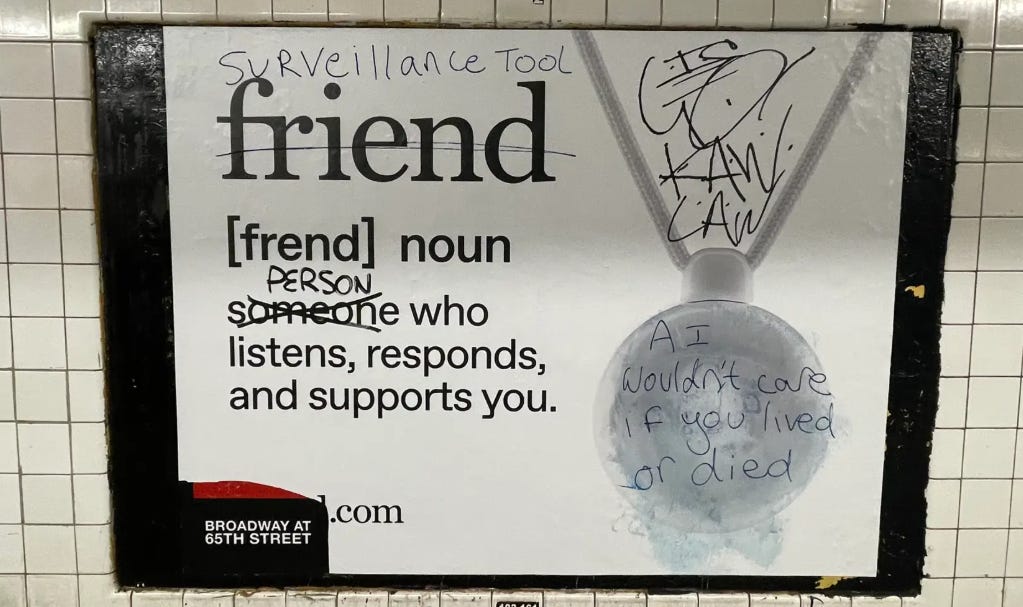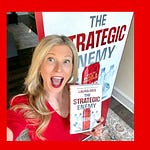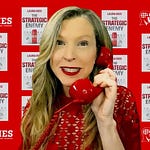A positioning strategy that leverages a strategic enemy is powerful. But not just any enemy will do. Get your enemy right, and you have a brand worth fighting for. Get it wrong, and well... let me tell you about Friend.com.
Over the last six weeks, an AI start-up called Friend has blanketed New York City’s subway system with one of the most talked-about—and vandalized—advertising campaigns in recent memory. The product? A $129 wearable AI pendant that will listen to your conversations and become your friend.
The positioning was clear and bold: Friend positioned itself against the unreliability, judgment, and complications of real human friendships.
In other words, they made real friends, their strategic enemy.
Friend’s subway campaign launched with stark black text on white backgrounds flooding stations across all five boroughs. The messages were provocative: “I’ll never bail on our dinner plans.” Another read: “Stop texting your ex. Text your Friend instead.”
The backlash was swift and widespread. New Yorkers armed with Sharpies transformed the ads into protests. “A.I. is not your friend” appeared on one poster. “Make a real friend” was scrawled across another. Some ads were ripped down altogether.
Friend’s positioning error: they made human connection the villain in their brand story. And New Yorkers, living in one of the world’s most densely populated yet loneliest cities, weren’t having it.
Picking the Right Enemy
A strategic enemy is an oppositional force that your brand stands against. Having an enemy isn’t about hate or declaring war, it’s about creating contrast that brings clarity to your positioning.
Your strategic enemy needs to be something consumers are genuinely frustrated with a category that’s outdated, a convention that’s inconvenient, a competitor that’s failing to deliver.
Real human friendship doesn’t fit that criteria.
The pitch is seductive. Real friends are busy. They have their own problems. They might judge you. They’re not available at 3 AM when you’re spiraling. An AI friend is always there, always positive, always focused on you.
But positioning against human connection fundamentally misunderstands what makes a strategic enemy work: you need consumers to accept your enemy as worthy of defeat. And deep down, nobody really believes real friendship is the problem that needs solving.
Schiffmann has tried to reframe the narrative, claiming he doesn’t view Friend as dystopian. “To him, the A.I. friend is a new category of companionship, one that will coexist alongside traditional friends rather than replace them,” according to a New York Times article.
“We have a cat and a dog and a child and an adult in the same room,” he said. “Why not an A.I.?”
But that’s not what the positioning communicated.
When you name your product “Friend” with a capital F, when you plaster subways with messages telling people they don’t need more friends, when your launch videos that show users choosing AI over human interaction, you’ve made your positioning clear.
As of early October, Schiffmann has sold around 3,100 pendants, though he expects that it will increase when the product hits Walmart next year.
He even sees the attention and vandalism as positive, “People don’t vandalize an irrelevant ad, right?”
Maybe. Or maybe people vandalize ads that fundamentally misunderstand human nature and position against something sacred: genuine human connection.
The Four Tests Every Strategic Enemy Must Pass
Friend’s failure shows why choosing the right strategic enemy is so important. Every strategic enemy must pass these four tests:
1. Genuinely frustrating in consumers’ minds
The enemy must be something consumers are frustrated with. Real friendship doesn’t qualify. Barriers to friendship do.
2. Creates a compelling contrast
The enemy should make your difference clear and compelling. Friend’s positioning only clarified how much people value human connection and made its product sound like a sad replacement.
3. Solvable by your product
Your brand should beat the enemy in a way that improves lives. Friend can’t defeat the “problem” of human friendship without making people’s lives worse, not better.
4. Acceptable to attack without moral backlash
You need permission to position against your enemy. Positioning against plastic bottles? Acceptable. Positioning against human connection? Not acceptable.
Friend failed on all four. Nobody wakes up wishing they had fewer real friends and more AI companions. They wake up wishing it was easier to maintain real friendships, overcome social anxiety, or find their people in an increasingly disconnected world.
Make Your Brand Worth Fighting for
Your strategic enemy is one of the most important branding decisions you’ll make. It should:
● Give your positioning clarity and contrast
● Rally people to your cause
● Make your difference instantly understandable
● Create a debate that keeps your brand top of mind
But it must be the right enemy. One that consumers want to defeat. One that your brand can credibly challenge. One that makes the world better when conquered, not worse.
Friend.com positioned themselves against the very thing we all want more of – human connection. The graffiti-covered subway ads weren’t just vandalism. They were a visceral rejection of positioning that fundamentally misread human nature.
The strategic enemy is one of the most powerful tools in your positioning arsenal. Choose it wisely. Friend.com didn’t, and the humans fought back.











